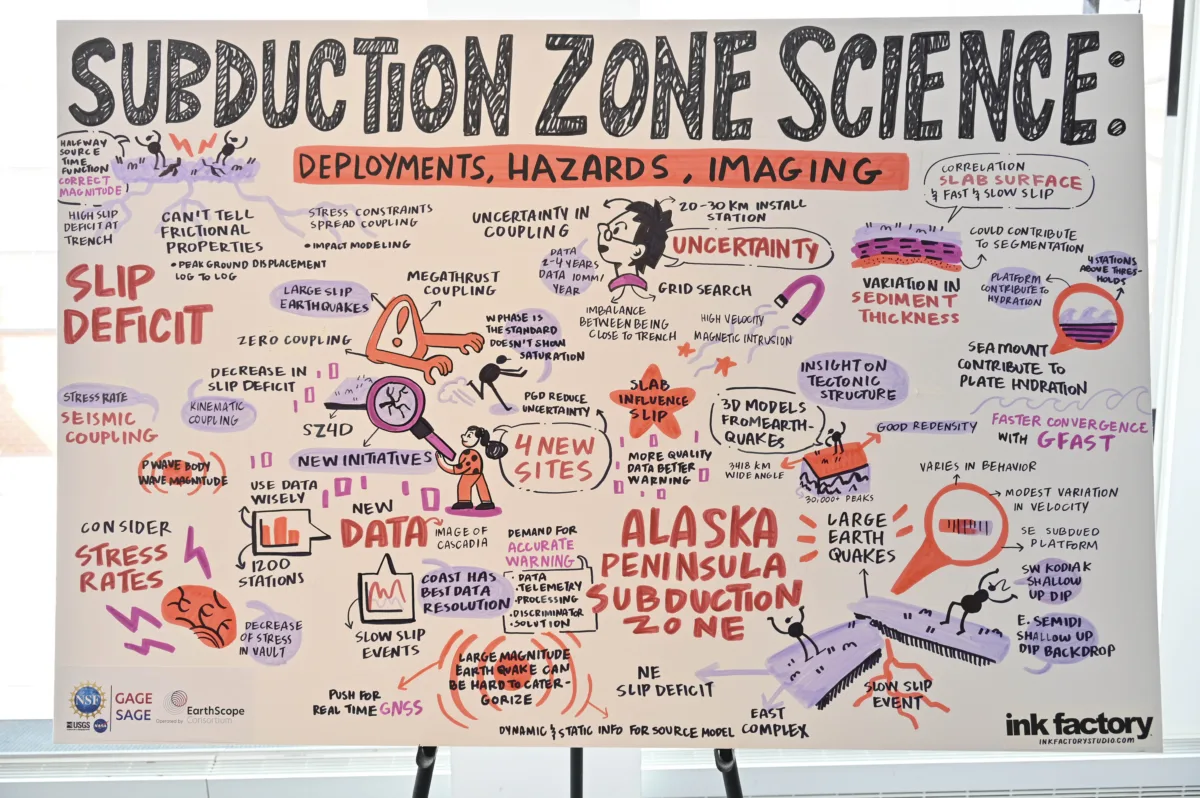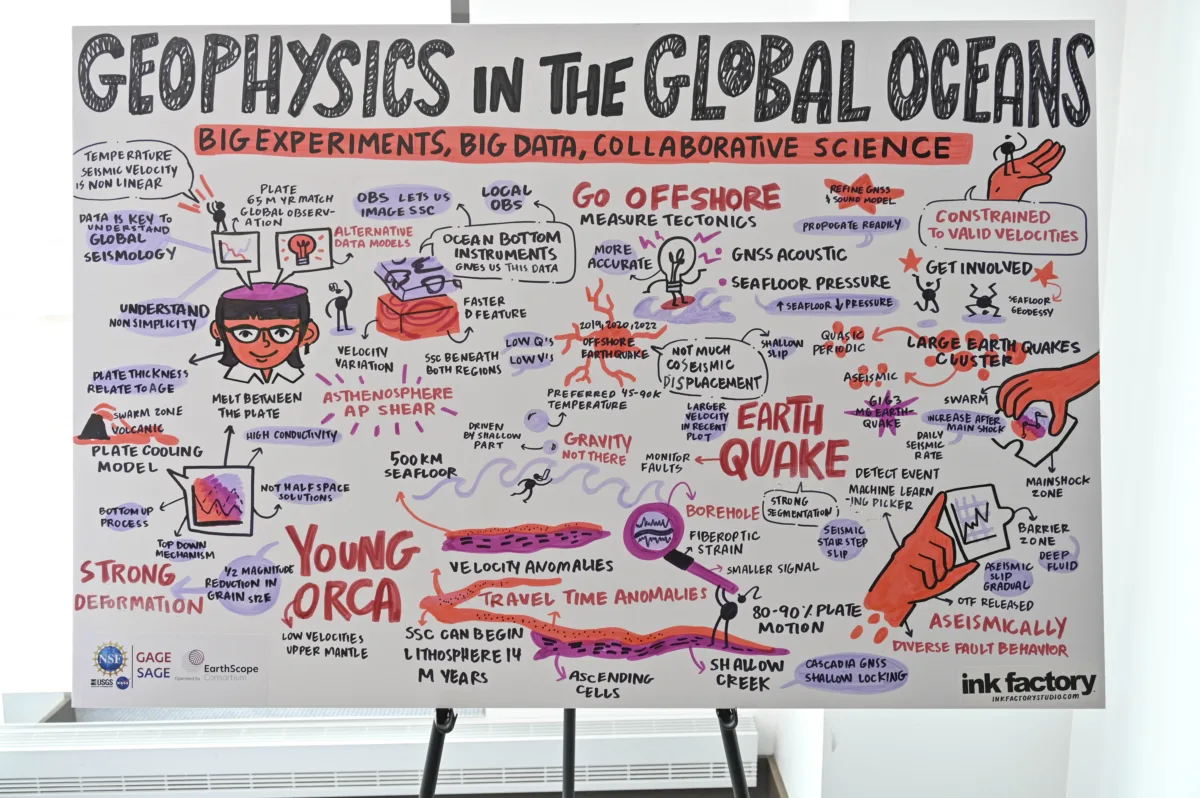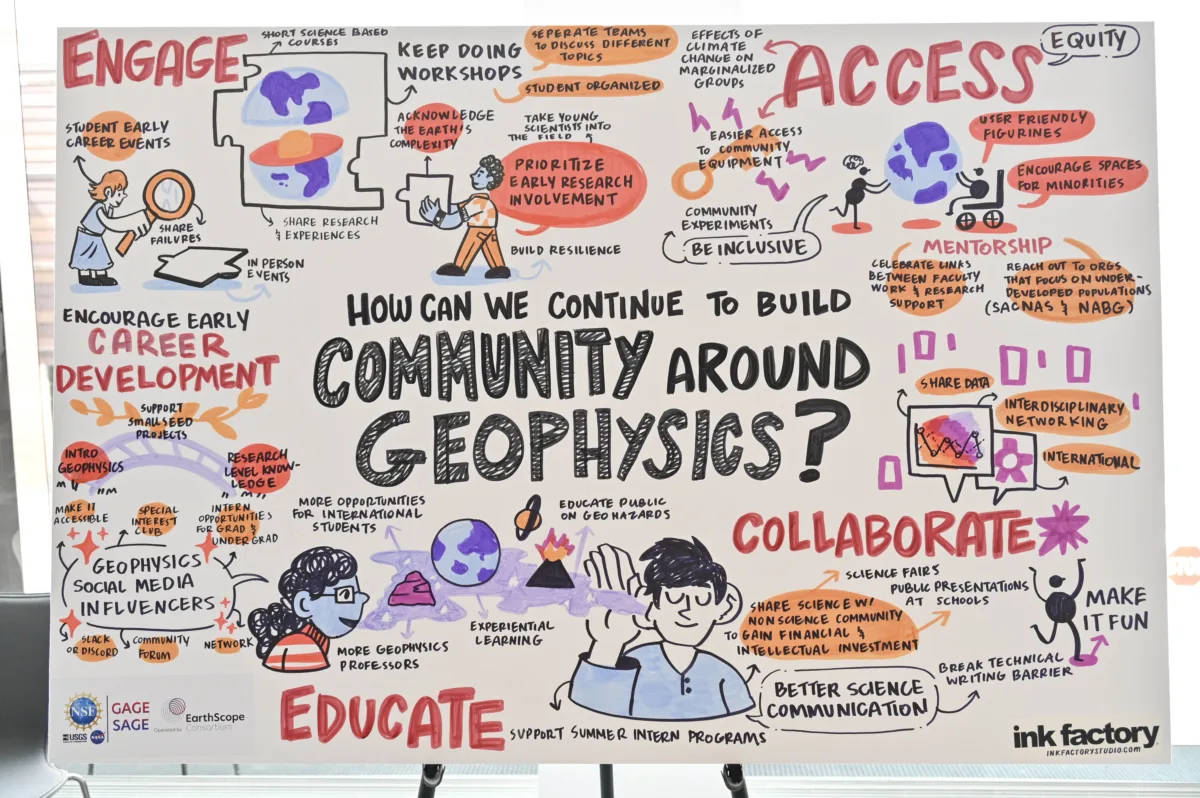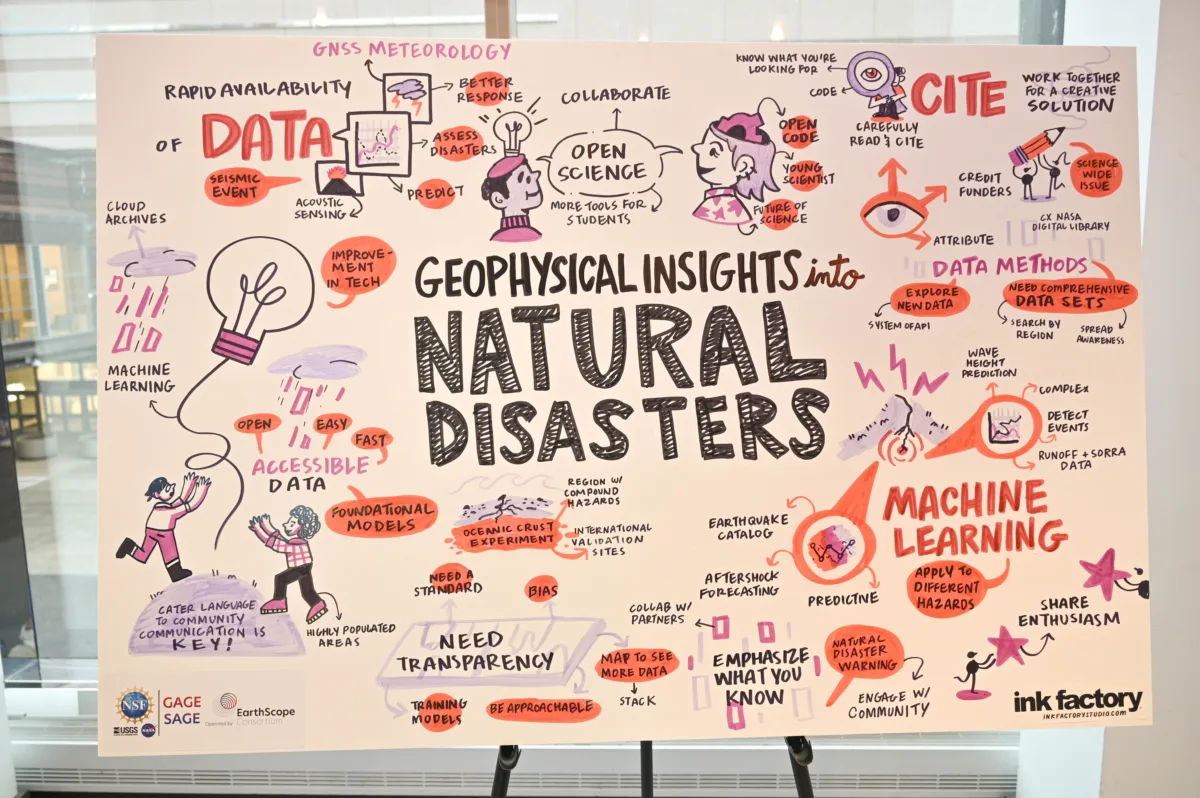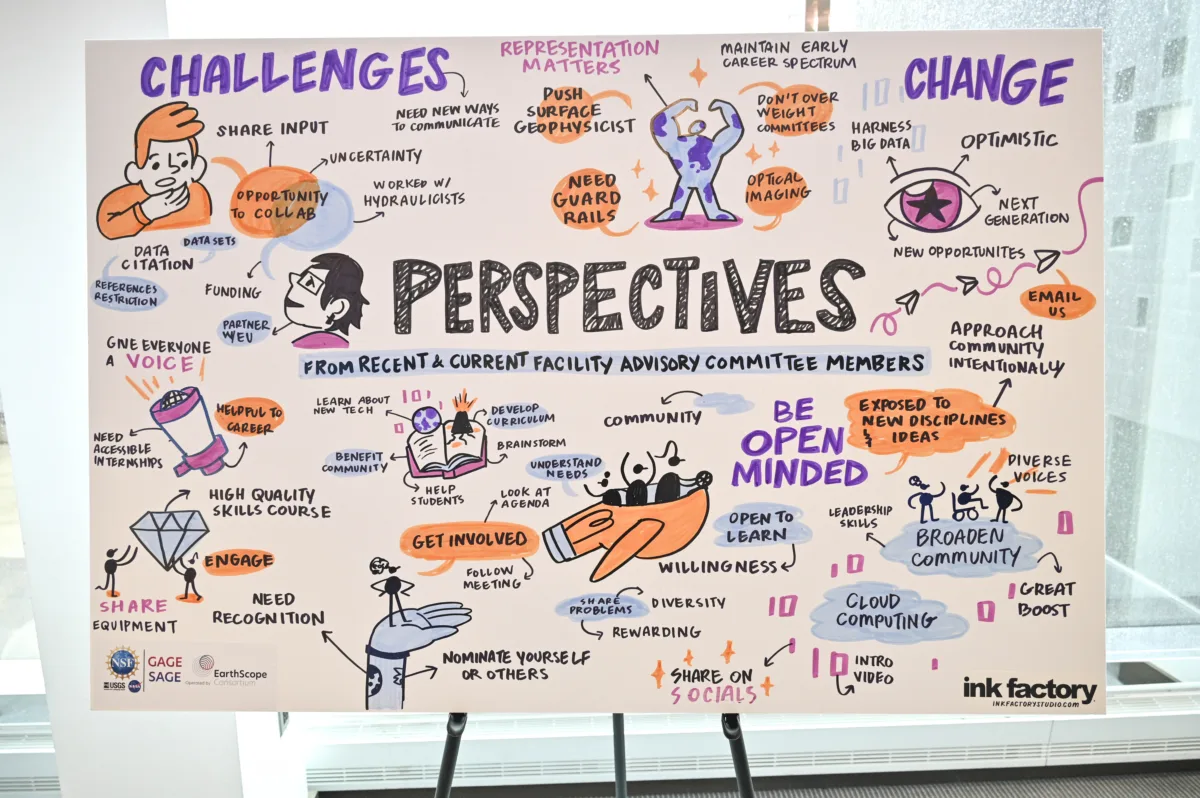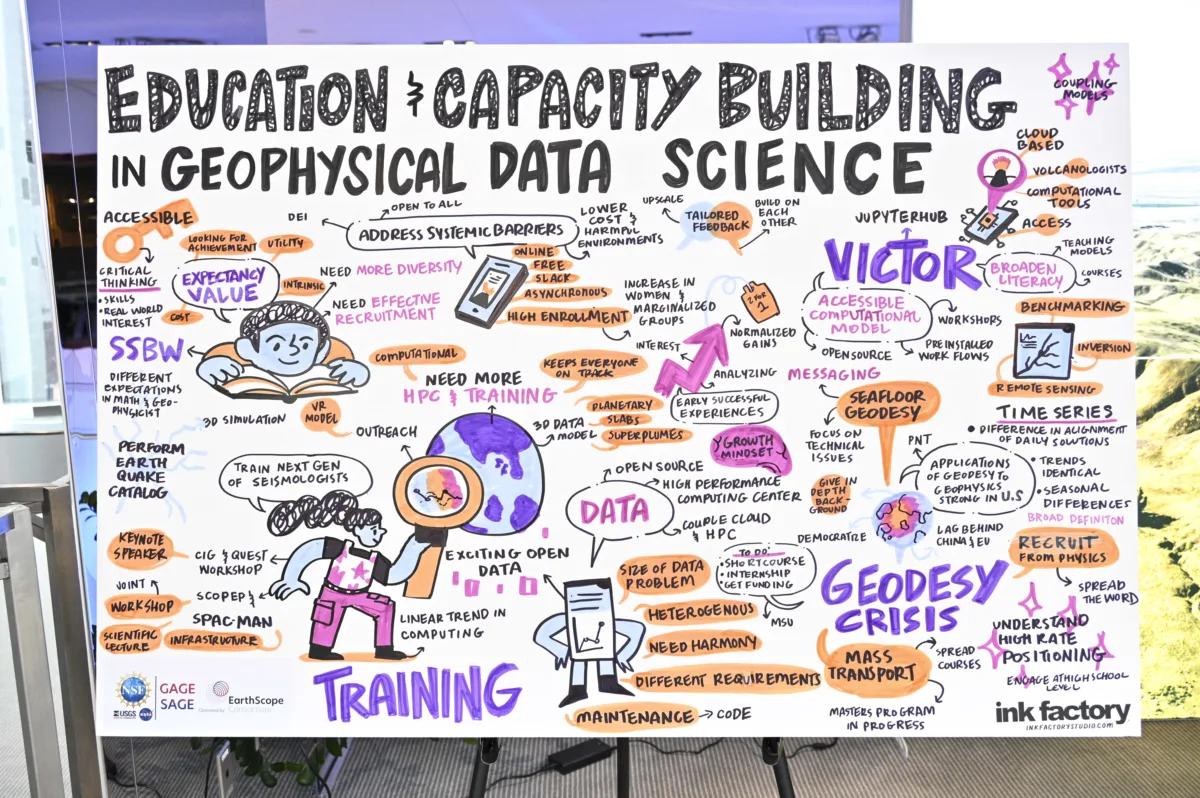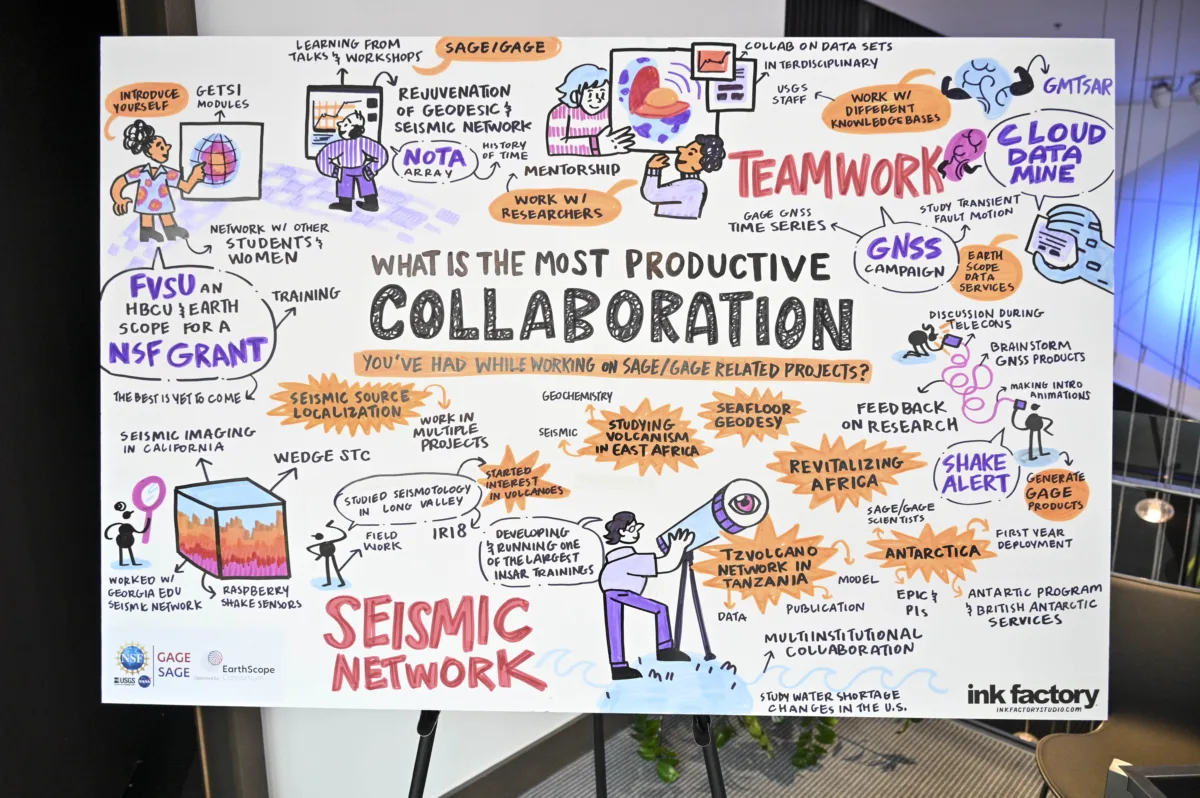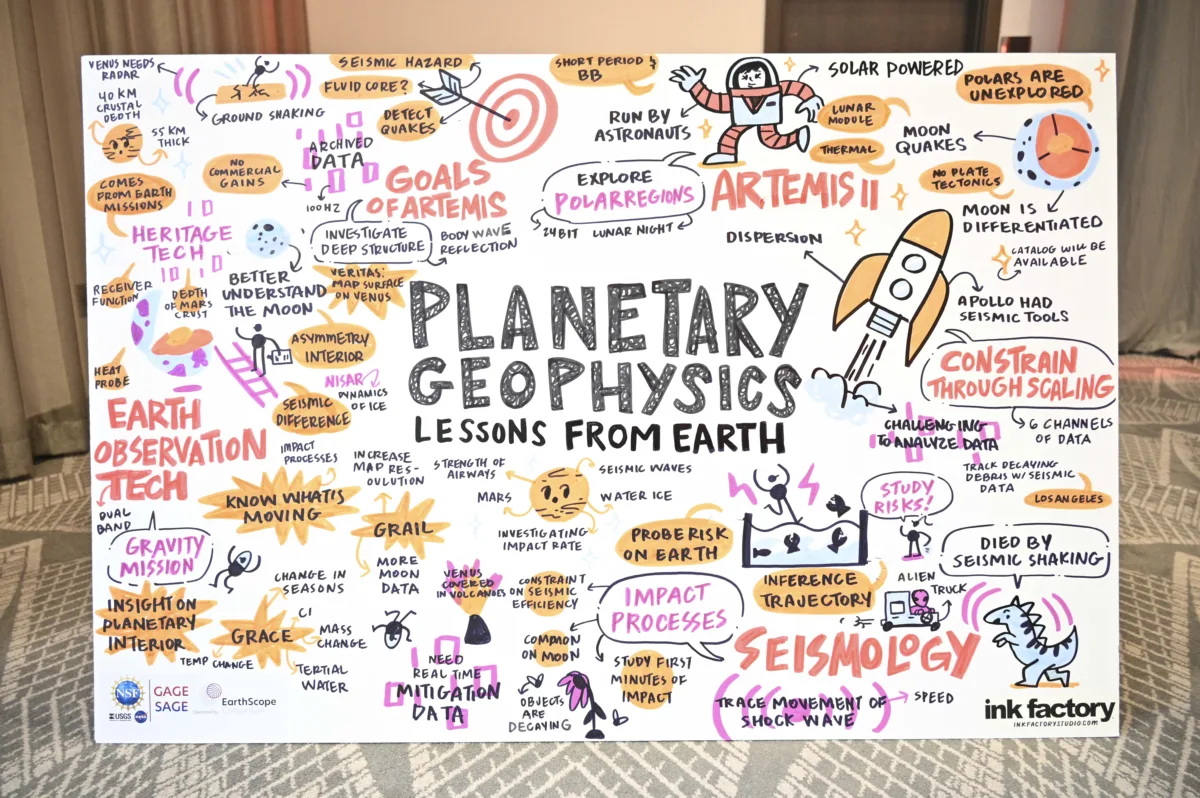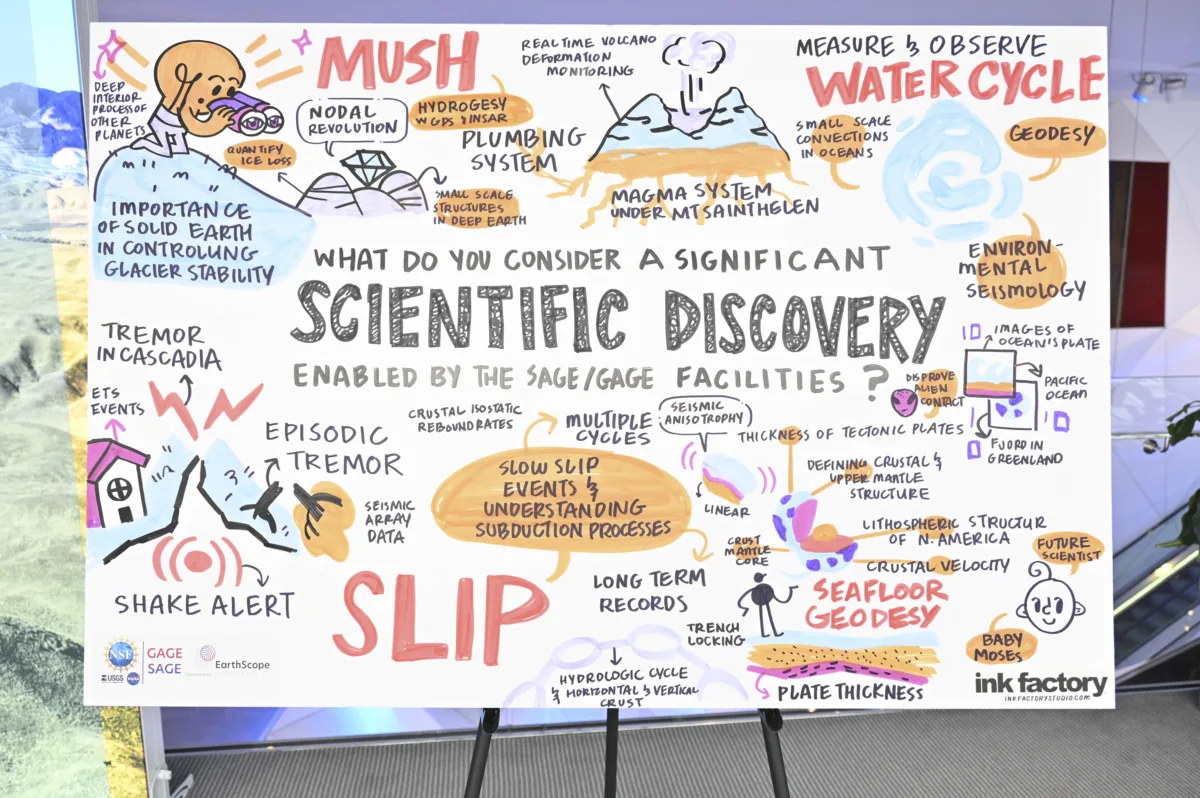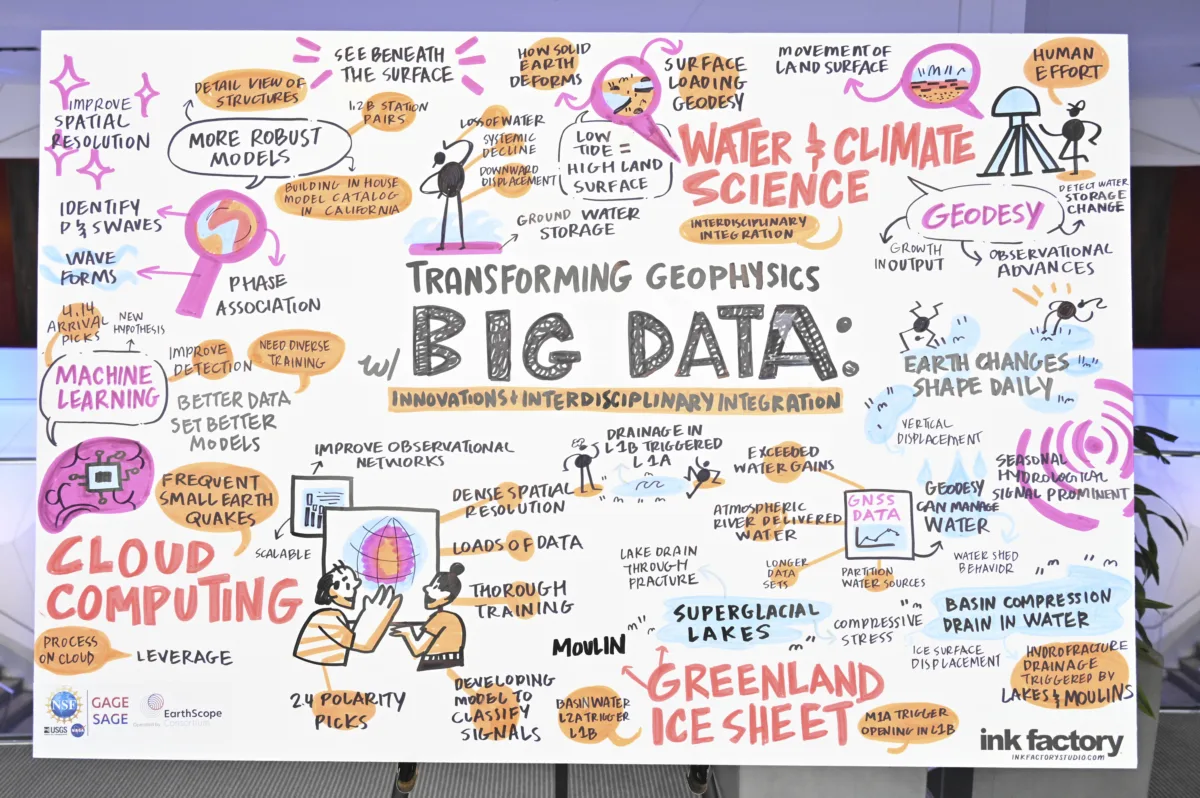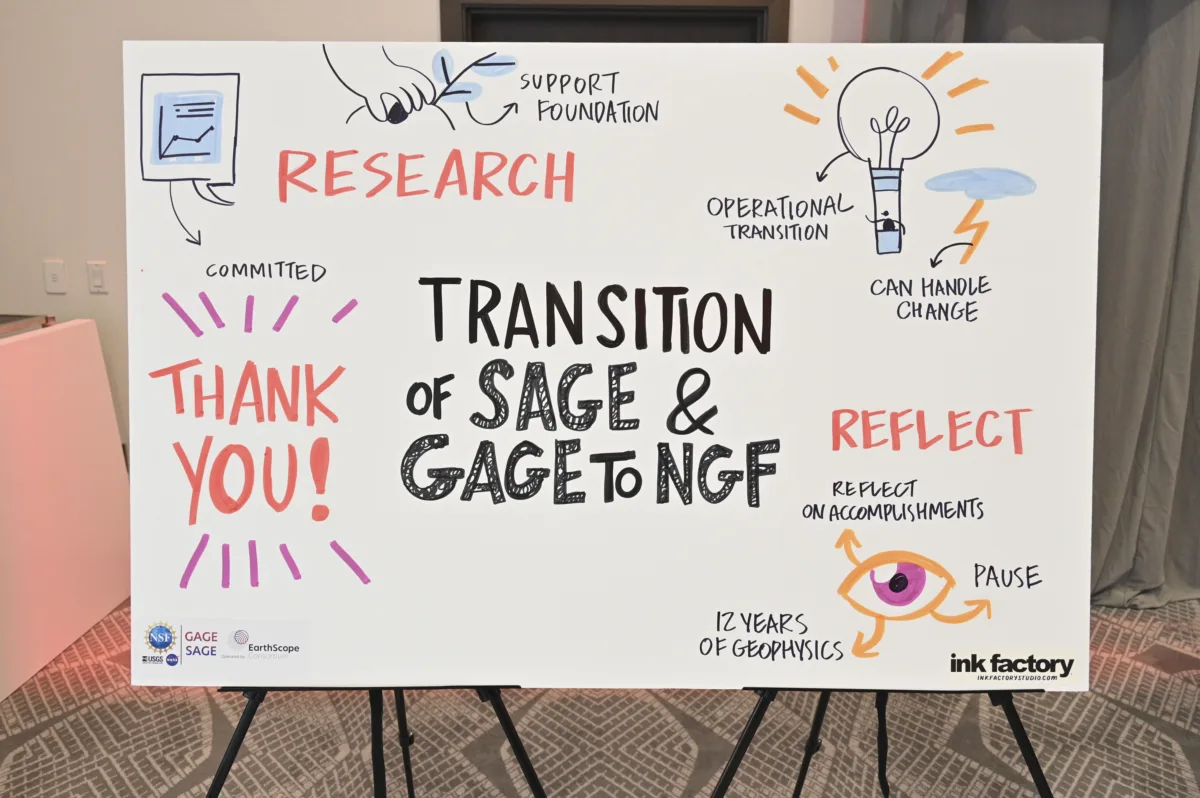
This workshop focuses on geophysical research on the solid Earth, cryosphere, oceans, atmosphere, and even other planets. It provides an opportunity to learn about cutting edge science, engage with other members of the community, and expand technical skills.
The workshop is sponsored by the the U.S. National Science Foundation, National Aeronautics and Space Administration, and U.S. Geological Survey. EarthScope operates the NSF Geodetic Facility for the Advancement of Geoscience (GAGE) and the NSF Seismological Facility for the Advancement of Geoscience (SAGE).
Important Deadlines:
- April 20 – Abstract deadline
- April 25 – Last day to book a hotel room in our block
- April 25 – Last day to receive a refund if you cancel registration
- April 29 – Last day to for dietary restrictions to be accounted for during registration
- May 9 – Last day to register; there is no on-site registration
Registration
Registration is now closed! We look forward to seeing everybody soon.
Format
The workshop will be held in-person with no virtual component.
All meeting attendees will be required to adhere to the EarthScope Code of Conduct.
Workshop Leadership
Science Planning Committee
- Aditya Kar, Ft. Valley State University
- Bill Holt, Stony Brook University
- Franz Meyer, University of Alaska Fairbanks
- Tolulope Olugboji, University of Rochester
EarthScope Planning Contacts
- Gillian Haberli, EarthScope Consortium
- Krystin Poitra, EarthScope Consortium
Questions? Please contact workshop@earthscope.org for more information.
Workshop Agenda
Sunday, May 18
7:00 AM – 8:00 AM – Field Trip Check-in Location: SkyBridge
8:00 AM – 6:00 PM – Field Trip
- From Rift to River: Exploring the Geologic History of Minnesota
12:00 PM – 2:00 PM – Short Course Registration Location: SkyBridge
1:00 PM – 5:00 PM – Short Courses
- Unlocking Student Potential: Supporting Equitable and Effective Teaching and Mentoring (Location: Nakomis C)
- GAMIT/GLOBK Refresher and Recent Developments (Location: Nakomis A)
- Cloud 101: An Introduction to EarthScope’s GeoLab Jupyter Hub and Geophysics in the Cloud (Location: Harriet AB)
- Introduction to OpenTopography Tools for Calculating Change at the Earth’s Surface (Location: Nakomis B)
3:00 PM – 7:00 PM – Early Registration Location: SkyBridge
3:00 PM – 7:00 PM – Poster Set-Up Location: Lake Ballroom, Salon CD
6:00 PM – 6:30 PM – First Time Attendee Meeting
Location: Minnetonka Ballroom
Monday, May 19 – Community Building Day
7:00 AM – 5:30 PM – Registration Location: SkyBridge
7:00 AM – 8:00 AM – Poster Set-Up Location: Lake Ballroom, Salon CD
8:00 AM – Welcome & Introductory Remarks
Location: Lakes Ballroom, Salon AB
Speakers: Becks Bendick (EarthScope CEO, NSF GAGE and SAGE PI), Gareth Funning (EarthScope Board of Directors Chair), remarks from federal sponsors
8:30 AM – Plenary Session #1: Subduction Zone Science: Deployments, Hazards, Imaging
Location: Lakes Ballroom, Salon AB
Co-Chairs: Julie Elliott and Doug Wiens
- Eric Lindsey: Imaging the Shallow Megathrust Slip Deficit: From Onshore Archives to Offshore Needs
- Anne Bécel: Link between Seismic structure and Megathrust Slip Behavior in the Alaska Subduction Zone
- Brendan Crowell: Earthquake and Tsunami Early Warning with GNSS
10:00 AM – Break *All posters must be up by 10:30 AM
10:30 AM – Plenary Session #2: Geophysics in the Global Oceans: Big Experiments, Big Data, Collaborative Science
Location: Lakes Ballroom, Salon AB
Co-Chairs: Noel Jackson and Joshua B. Russell
- Zach Eilon: Small-scale Convection beneath the Oceanic Plates
- John DeSanto: GNSS-A in Cascadia and Alaska and Near-Trench Coupling
- Jianhua Gong: Microseismicity Patterns and Fault Slip Behaviors along the Gofar Transform Fault
12:00 PM – Group Photo Location: Lakes Ballroom, Salon AB
12:20 PM – Working Lunch: How Can We Continue to Build Community Around Geophysics?
Location: Minnetonka Ballroom
1:30 PM – SIG Session #1
- Updates from Instrumentation Services Portfolio (Location: Nakomis C)
Co-Leads: Samantha Hansen, Glen Mattioli, Greg Chavez, Chris Calvelage, Gizem Karslioglu, Pnina Miller, Karl Feaux, Annie Zaino - EarthScope’s Transition to the Cloud: Current Status, On-Ramp Initiative, and Research Impacts (Location: Cedar)
Co-Leads: Marine Denolle, David Mencin, Chad Trabant, Tammy Bravo - Using Geophysics Instruments to Support “Learn by Doing” in University Teaching (Location: Nakomis A)
Co-Leads: Yawar Hussain, Beth Pratt-Sitaula - SZ4D (Subduction Zones in Four Dimensions): Building on Progress and Future Outlook (Location: Harriet A/B)
Co-Leads: Mike Brudzinski, Jerry Carter
3:00 PM – Afternoon Break
3:30 PM – Poster Session #1
Location: Lakes Ballroom, Salon CD
5:30 PM – Poster Session Ends
5:30 PM – Panel Discussion (Geophysical Insights into Natural Disasters)
Location: Lakes Ballroom, Salon AB
6:45 PM – Adjourn for the Day
Tuesday, May 20 – Community Engagement and Collaboration
6:30 AM – 5:00 PM – Registration Location: SkyBridge
7:00 AM – Student and Early Career Mentoring Breakfast Location: Minnetonka Ballroom
9:00 AM – Panel Discussion: Getting Involved with the Facilities – Perspectives from Recent and Current Facility Advisory Committee Members Location: Lakes Ballroom, Salon AB
10:00 AM – Break
10:30 AM – Plenary Session #3: Education and Capacity Building in Geophysical Data Science
Location: Lakes Ballroom, Salon AB
Co-Chairs: Gareth Funning and Sarah Stamps
- Ebru Bozdag: From SCOPED to SPAC-MAN: Leveraging HPC/Cloud Computing and Immersive Visualization in Training Next-Generation Seismologists and Public Outreach
- Mike Brudzinski: Open, Engaged Learning Increases Expectancy-Value and Substantially Broadens Participation
- Einat Lev: VICTOR — A New Cyber Infrastructure for Volcanology
- Jeff Freymueller: Building the Future Geodesy Workforce
12:30 PM – Plenary Session Ends
12:45 PM – Working Lunch: What Is the Most Productive Collaboration You’ve Had While Working on NSF SAGE/GAGE Related Projects?
Location: Minnetonka Ballroom
1:45 PM – Lunch Ends
2:00 PM – SIG Session #2
- Seafloor Geodesy Capabilities in NGF: Identifying the Needs of the Community (Location: Harriet A/B)
Co-Leads: Andy Newman, Glen Mattioli - Near Surface Geophysics Capabilities in NGF: Identifying the Needs of the Community (Location: Cedar)
Co-Leads: Sarah Kruse, Pnina Miller - Educational, Workforce Development, and Communication Capabilities of the NGF: Identifying the Needs of the Community (Location: Nakomis C)
Co-Leads: Franz Meyer, Michael Hubenthal, Sophia Parafina, Tammy Bravo
3:30 PM – Break
4:00 PM – Poster Session #2
Location: Lakes Ballroom, Salon CD
6:00 PM – Poster Session Ends
Wednesday, May 21 – Looking Ahead & Closing the Loop
8:30 AM – 1:00 PM – Registration Location: SkyBridge
8:30 AM – 2:00 PM – Poster Tear-Down *Any posters left up after 2:00pm will be discarded
9:00 AM – Community Session: SIG Report Outs
Location: Lakes Ballroom, Salon AB
10:00 AM – Plenary Session #4: Planetary Geophysics: Lessons from Earth
Location: Lakes Ballroom, Salon AB
Co-Leads: Indujaa Ganesh and Carolina Beghein
- Angela Marusiak: LEMS-A3: The Lunar Environmental Monitoring Station an Artemis III Deployed Instrument for the Seismic Exploration of the Lunar South Pole
- Ben Fernando: Probing Impact Processes Through Seismology – From Earth to the Moon and Mars
- Susan Owen: From Earth to the Solar System: Earth Observation Technologies for Planetary Science Missions
11:30 AM – Plenary Session Ends
11:40 AM – Working Lunch: What Do You Consider a Significant Scientific Discovery Enabled by the NSF SAGE/GAGE Facilities?
Location: Minnetonka Ballroom
1:00 PM – Plenary Session #5: Transforming Geophysics with Big Data: Innovations and Interdisciplinary Integration
Location: Lakes Ballroom, Salon AB
Co-Leads: Marine Denolle and John-Morgan Manos
- Weiqiang Zhu: Advancing Big Data Analysis in Seismology with Machine Learning and Cloud Computing
- Hilary Martens: Advances in Water and Climate Science Enabled by Large-Scale Geophysical Datasets
- Stacy Larochelle: Hydro-fracture-driven Drainage of Greenland Supraglacial Lakes Triggered by Nearby Lakes and Moulins
2:30 PM – Plenary Session Ends
2:30 PM – Community Session: Transition of NSF SAGE and GAGE to NSF NGF
Location: Lakes Ballroom, Salon AB
Speaker: Becks Bendick
2:50 PM – Closing Remarks
Location: Lakes Ballroom, Salon AB
Speaker: Becks Bendick
3:00 PM – Workshop Concludes
Free half-day short courses will be offered Sunday May 18, 2025—the day before the main workshop begins, from 1 pm to 5 pm CDT.
Once registration opens, you will be able to register for short courses during the regular workshop registration process. Short courses are concurrent, so you can only sign up for one. Space is limited—please only sign up if you actually plan to attend. If you decide at a later date you would like to register for a short course, contact workshop@earthscope.org.
Please click on each short course title for a brief description.
Short Courses:
Unlocking Student Potential: Supporting Equitable and Effective Teaching and Mentoring
Do you have the keys to unlock student potential in your lab and classroom? Education research provides conclusive evidence about how people learn, the science of mentoring relationships, and effective teaching and mentoring strategies. Through hands-on activities, discussion, and an implementation framework, attendees will leave with concrete strategies and resources to enhance their teaching and mentorship. Faculty and graduate students will also benefit from shared perspectives, gaining insights on how research-informed practices can be woven into both instructional and research settings. This session builds upon two recent reports from the National Academies of Sciences, Engineering, and Medicine that offer key insights for unlocking student potential.
To help offset the cost of Community Science Workshop registration fees, a stipend of $250 will be provided to regular attendees and $150 to student attendees. Stipends will be issued upon successful completion of the workshop and submission of an implementation plan.
GAMIT/GLOBK Refresher and Recent Developments
“GAMIT/GLOBK Refresher and Recent Developments” is designed for established and experienced users of GAMIT/GLOBK to refresh their working knowledge of the software, learn about recent developments and evolving best practices, and to have one-on-one tutorials and discussions with the maintainers of the software. Examples of topics to discuss include, but are not limited to, learning about models and tables updated over the last few years; the addition or rewriting of scripts and programs for new capabilities; the use of cluster systems for processing large networks or long time periods; and the release of ITRF2020/IGb20 and the intricacies due to the inclusion of defined seasonal terms for the first time.
Instructors/Presenters:
Tom Herring (MIT, tah@mit.edu) and Mike Floyd (MIT, mfloyd@mit.edu)
Cloud 101: An introduction to EarthScope’s GeoLab Jupyter Hub and Geophysics in the Cloud
EarthScope is excited to expand access to new cloud compute resources as we migrate our data repositories into cloud storage. This workshop will introduce GeoLab, EarthScope’s data-adjacent JupyterHub, and discuss strategies for migrating existing workflows to the cloud.
We invite all levels of learners to our cloud computing platform, regardless of prior experience with leveraging cloud resources, and welcome researchers and educators of any geoscience domain. This is an entry-level workshop that will introduce some basic features of GeoLab, highlight opportunities for collaboration on the platform, discuss core cloud computing best practices, and provide brief examples for accessing EarthScope’s seismic and geodetic cloud repositories for further analysis. The data access demos will be conducted in python, so participants will get the most out of the course with some prior basic python experience, but the GeoLab platform also includes an RStudio environment for those more familiar with coding in R. The workshop will include dedicated time for individuals or small groups to work independently in GeoLab and further explore its usability and features for their own purposes.
Instructors/Presenters:
Sarah Wilson, Tammy Bravo, Robert Weekly, Chad Trabant, and Alex Hamilton
Introduction to OpenTopography Tools for Calculating Change at the Earth’s Surface
The growing availability of multi-temporal high resolution topography datasets from lidar and photogrammetry offer the opportunity to reveal surface change from a variety of tectonic, geomorphic, and anthropogenic processes including earthquakes, volcanic eruptions, river erosion, landslides, sand dune migration, and urban development. OpenTopography is an NSF supported initiative that strives to streamline hosting, discovery, processing, visualization, and analysis of topographic data.
This short course will provide introduction to the OpenTopography platform for accessing and processing high-resolution topography, with a focus on tools for computing topographic change from multi-temporal data. After a brief refresher on lidar and structure from motion photogrammetry, we will explore OpenTopography’s on-demand tools for calculating vertical differences between overlapping datasets. We will also discuss how to interpret topographic change results using new a uncertainty analysis tool. Through hands-on exercises, attendees will learn to process multi-temporal datasets to quantify landscape change, and to correctly interpret differencing results. This workshop is ideal for students, educators, researchers, and professional geoscientists looking to gain practical experience in using freely available, high-resolution topographic data and OpenTopography’s streamlined processing capabilities.
Instructors/Presenters:
Cassandra Brigham and Christopher Crosby
Venue
The Workshop will be held at the Radisson Blu Mall of America in Bloomington, Minnesota
2100 Killbrew Drive
Bloomington, MN 55425
952-314-5116
Booking Information
EarthScope has secured a block of rooms at the Radisson Blu.
Room Rate: $185/night (single/double occupancy), $205/night (triple/quadruple occupancy). Rates are not inclusive of a 16.025% applicable taxes.
Hotel Cut-off date is April, 25, 2025. You can make your reservation by calling: 952-314-5116 and mentioning group code: 2025 SAGE/GAGE Workshop, or by using the online hotel reservation link.
Check-in: 3:00pm local time.
Check-out: 12:00pm local time.
Please note that the hotel may charge for early arrivals.
Airport/Transportation
The nearest airport is Minneapolis-St. Paul International Airport (MSP), which is about 5 miles from the host hotel.
The Radisson offers a daily complimentary shuttle that runs from 5:00am-11:00pm local time. Shuttles run every 30 minutes, at the top and bottom of the hour. Once at the airport, please call 952-314-5116 to alert the driver of your arrival. Please make a reservation with the front desk 24 hours prior to your departure date/time. Space per shuttle is limited.
Local Information
There is direct access to Mall of America by skyway, with dozens of dining experiences, ranging from fast food to high-class restaurants, with up to 500 stores available for shopping, and several attractions, all located just a few steps from our meeting space.
Bloomington, Minnesota, offers a diverse culinary scene that caters to every palate. Whether you’re in the mood for upscale dining, casual eateries, or international flavors, you’ll find a variety of options to satisfy your cravings
Parking
The Radisson Blu charges $24/day for Overnight Self-Parking and $34/day for Overnight Valet Parking. These parking options are based on availability for registered hotel guests, restaurant patrons, and guests attending events.
There are also alternative Parking options at the Mall of America, should the hotel’s parking ramp be full.
As a guest of the hotel, the East Ramp, West Ramp and L.L. Bean lot are convenient locations and available to you. Please be advised that the Mall of America policy states that there is to be no overnight parking allowed on the top floor of the ramps. Once you have parked, enter the mall and head towards the south side second floor hotel Skyway between J. Jill and Brighton, to enter the Radisson Blu. Should you utilize the Mall of America’s parking ramp, you will need to fill out a parking form with the Radisson Blu hotel, that notes the vehicle information (license plate number, vehicle make/model/color), as well as the parking space information (ramp- east/west, aisle/row, etc.)
***Please be aware that the glass door that connects the Radisson Blu Skyway to the Mall of America closes at 11:00 PM. If your group is returning from the Mall of America after 11:00 PM, please utilize the hotel’s main floor front entrance/lobby.
From Rift to River: Exploring the Geologic History of Minnesota
2025 NSF GAGE/SAGE Field Trip
Please sign up for the field trip during registration, before April 30th
Date: May 18, 2025
Time: Full-day event
Itinerary:
- Saint Anthony Falls – Paleozoic geology and geoengineering history.
- Minnehaha Falls – Limestone and Saint Peter Sandstone formations.
- Interstate State Park – Glacial potholes, MCR basalts, and a discussion on geophysical signatures. Includes an 80-minute riverboat tour, with geological insights on the Saint Croix River.
This field trip will explore key geological sites in the Minneapolis-St. Paul region, focusing on Paleozoic geology, glacial formations, and the Midcontinent Rift.
Logistics:
- Pickup: 8:00 AM | Drop-off: 4:00–6:00 PM
- Travel: Estimated 1-hour max between locations
Join us for the 2025 NSF GAGE/SAGE Field Trip on May 18th! This full-day experience offers a great opportunity to explore local geology. While the exact details are still being finalized, we’re planning a memorable day that you won’t want to miss.
You can add the field trip to your registration for an additional fee.
2025 NSF GAGE/SAGE Special Interest Groups (SIGs)
Special Interest Groups (SIGs) are focused sessions designed to give participants a deeper dive into specific topics of interest. Each SIG provides a unique opportunity to engage with like-minded peers and explore specialized subjects in a collaborative setting.
Session 1: Monday
Updates from Instrumentation Services Portfolio
Co-Leads: Samantha Hansen, Glen Mattioli, Greg Chavez, Chris Calvelage, Gizem Karslioglu, Pnina Miller, Karl Feaux, Annie Zaino
This Special Interest Group (SIG) will provide the community with an overview of the status of the Instrumentation Services Portfolio including updates on the Common Sensor Platform (CSP), Distributed Acoustic Sensing (DAS) interrogator power system development and testing, and seismometers and GNSS equipment. In addition to a summary of updates, input from the community for short term needs and long term strategies will be gathered.
EarthScope’s Transition to the Cloud: Current Status, On-Ramp Initiative, and Research Impacts
Co-Leads: Marine Denolle, David Mencin, Chad Trabant, Tammy Bravo
This session will provide an overview of EarthScope’s strategic transition to the AWS-based Common Cloud Platform (CCP), how we are working to ensure that the benefits of the cloud-based facility will be available to the research communities we support, and an example of research computing in the cloud.
EarthScope continues to transition the data centers we operated to support the NSF GAGE and NSF SAGE facilities to the Common Cloud Platform in AWS. The operational benefits for EarthScope are many and include significantly increased robustness, on-demand scalability, and the opportunity for modernization. Many of these benefits can also be leveraged by researchers and other users of these facilities. To support users transitioning their workflows into the cloud, EarthScope’s On-Ramp initiative is creating tools such as a JupyterHub-based GeoLab, sample notebooks, documentation, and hosting training courses. The primary goal of On-Ramp is to provide cloud compute capability adjacent to the data repositories managed by EarthScope to a broad audience. We anticipate that GeoLab will satisfy many educational, prototyping and research needs. In advanced cases, researchers may wish to create their own AWS account with On-Ramp staff consulting on how best to orchestrate their analysis needs. As an example of such an advanced use case, the Datamine project has processed just over one petabyte of data managed by the NSF SAGE facility, applying ML techniques to generate a database of event detections and source discrimination. We look forward to discussing our experiences so far and what you will be able to do in the cloud.
Using Geophysics Instruments to Support “Learn by Doing” in University Teaching
Co-Leads: Yawar Hussain, Beth Pratt-Sitaula
Integrating geophysics instrumentation into undergraduate and graduate programs enhances the learning experience for students by allowing them to engage in hands-on geophysical data acquisition and problem-solving. This approach bridges the gap between theory and practice while fostering interdisciplinary collaboration between geophysicists, engineers, and software specialists, ensuring that students gain practical experience and prepare for real-world challenges.
This session will bring together community members to identify ongoing challenges and practical solutions for using geophysics instruments at the university level. Leaders will overview strategies for reviving older geophysics instruments that may be already on campuses and how to borrow geophysics instruments from EarthScope, as well as available teaching resources for teaching about near-surface geophysics methods. Then the group will engage in an extended discussion of other challenges and solutions related to teaching with geophysics instruments and identify ways GAGE and SAGE can further support the community.
Goals
- Bring together geophysicists, engineers, educators, and students to identify ongoing challenges and practical solutions for using geophysics instruments at the college/university level.
SZ4D (Subduction Zones in Four Dimensions): Building on Progress and Future Outlook
Co-Leads: Mike Brudzinski, Jerry Carter
SZ4D is a community-driven initiative for a long-term, interdisciplinary research program to advance the science of geohazards to understand the limits and possibilities of prediction. Leveraging subduction zones as natural laboratories, SZ4D fosters interdisciplinary collaboration among scientists studying earthquake, volcanic, landslide, and tsunamigenic hazards and their cascading interactions. The purpose of this SIG is to update the community on recent and planned SZ4D activities, highlight opportunities available through existing programs such as SZNet, and seek community input on future directions.
Session 2: Tuesday
Seafloor Geodesy Capabilities in NGF: Identifying the needs of the community
Co-Leads: Andy Newman, Glen Mattioli
Join us for an engaging SIG focused on the possibilities presented by a new seafloor geodesy facility that is proposed to be established with the National Geophysics Facility (NGF). Whether you’re new or an existing user in the field, this gathering offers a unique opportunity to connect, and learn about the evolving applications of precise seafloor deformation measurements. These capabilities can be used for constraining plate rates of entirely oceanic lithosphere, deformation from fault locking and failure, submarine magmatism, submarine landslides, and anthropogenic pumping. We will discuss the planned implementation of the facility, including engineering and equipment support, new data products, training and other opportunities.
This is your chance to help shape the future of seafloor geodesy, forge new partnerships, and discover how this technology can unlock new insights hidden at oceanic depths.
Goals:
- Identify new faces interested in seafloor geodesy
- Find new ways in which we can grow this nascent facility functionality
- Learn about synergistic activities and data from the community
Near Surface Geophysics Capabilities in NGF: Identifying the needs of the community
Co-Leads: Sarah Kruse, Pnina Miller
This SIG will focus on the role of near-surface geophysics within the future NSF National Geophysics Facility (NGF). The NGF solicitation calls for the inclusion of near-surface geophysical instrumentation, and it is essential that the community provide input on how best to meet emerging scientific and societal needs. Near-surface geophysical investigations are essential to a wide array of Earth science challenges, including sharpening resolution of deep earthquakes, characterizing and monitoring geologic and cryospheric hazards, supporting infrastructure development, managing water resources, guiding environmental remediation, and addressing climate resilience. We invite members of the geophysical community to join us for a collaborative, discussion-based session aimed at identifying science and teaching priorities, instrumentation needs, and facility capabilities that would best support near-surface geophysics—with a particular eye toward enhancing seismic and geodetic research within the NSF-NGF. We especially encourage early career researchers and students to participate!
Goals
- Define the instrumentation, infrastructure, and facility services required to enable and support future near surface geophysical research and teaching directions.
- Solicit community input to help shape the vision for near-surface geophysics in the NGF.
Guiding Questions:
- In what sub-discipline/s of Earth and environmental science do you think you might use near-surface geophysics methods?
- What new or enhanced near-surface geophysical capabilities would most effectively enable or strengthen impactful, interdisciplinary investigations ?
- How can the NSF-NGF best support collaboration, innovation, and capacity-building in near-surface geophysics?
Educational, Workforce Development, and Communication Capabilities of the NGF: Identifying the needs of the community
Co-Leads: Franz Meyer, Michael Hubenthal, Tammy Bravo, Sophia Parafina
This SIG will focus on shaping the educational, workforce development, and communication capabilities of the NGF. We will collaboratively explore how the facility can support and empower both current and future users through integrated programs and infrastructure. Participants will help identify critical needs and priorities across all three areas. Framing examples for each area include the following.
Education
- Post-secondary curriculum and associated data access webtools.
- GeoLab JupyterHub environment, notebooks and data products
- Faculty professional development (e.g. integrating instrumentation into teaching)
Workforce
- Introductory and advanced (e.g. grad student and researchers) technical short courses (e.g. undergraduate and graduate)
- Documentation and tutorials for cloud workflows
- Research and professional internship experiences
- Digital credentialing to scaffold and recognize learning pathways for career development/reskilling
Communication
- Social media and newsletter messaging (e.g. On-Ramps)
- Producing outreach materials (e.g. print products, videos, website)
- Webinar series
Session Goals:
- Define the infrastructure and programming needed to support and empower NGF users across education, workforce development, and communication.
- Solicit community input to help refine a forward-looking vision that addresses evolving user needs.
- Identify priorities and opportunities for cutting-edge facility capabilities in these domains.
2025 NSF Gage/Sage Poster Sessions
Poster Sessions will be held during Monday, May 19 at 3:30pm-5:30pm and Tuesday, May 20 at 4:00pm-6:00pm.
Poster boards are 4 ft. x 8 ft.

You can begin putting up your poster on the afternoon of Sunday, May 18th, all posters must be placed no later than Monday 10:30 AM. All posters must be taken down no later than 2:00pm on Wednesday, May 21, any posters left behind will be discarded.
Poster board numbers and abstracts can be found here.
Exhibitors
We are offering up to fourteen (14) exhibit tables in the high-traffic registration area of the workshop, hosted at the Radisson Blu Mall of America hotel. This is your chance to display your products, services, and innovations to a targeted audience of professionals and experts.
Details:
- Cost: $1,200 per table (first-come, first-served basis)
- Included in your fee:
- One (1) 6.7’ x 2’ table (unclothed or black spandex skirting available)
- Tables will be assigned by the workshop organizers
- Two (2) chairs
- One (1) trash can
- One (1) 6.7’ x 2’ table (unclothed or black spandex skirting available)
- For any additional needs such as power, audio/visual equipment, or food/beverages, vendors will need to coordinate directly with the Radisson Blu and their AV partner, AVEX. Payment for these services will be made directly to the hotel.
Exhibit Setup & Take-Down:
- Available for setup: Sunday, May 18th (afternoon)
- Must be cleared by: 1:00 PM, Wednesday, May 21st
Please be advised that all exhibit representatives must register for the workshop and pay the registration fee in order to attend. Each exhibit table is allowed up to three (3) company representatives. After payment, you will receive further instructions for shipping, loading/unloading, parking, etc. The hotel may require proof of insurance.
If you’re interested in securing an exhibitor spot, or have any questions regarding the exhibit booths, please reach out to us at workshop@earthscope.org.
Sponsors
This year, we’re offering several sponsorship tiers that will provide your company with visibility and engagement opportunities before, during, and after the workshop. Below are the available sponsorship levels:
- Core (Poster Session) Sponsor – $5,000
- Logo displayed on signage inside or next to the designated event space
- Social media shout-outs before and after the workshop
- Recognition during the morning event announcements
- One complimentary workshop registration
- Mantle (Lunch) Sponsor – $8,000
- All Core Sponsor benefits, plus:
- Sponsor’s name/logo in the workshop program
- Social media post thanking the sponsor for their contribution
- Dedicated table during lunch for sponsor representatives and/or invited workshop guests (8-10 seats)
- Opportunity to provide a giveaway item during lunch
- All Core Sponsor benefits, plus:
- Crust (Poster Session & Lunch combo) Sponsor – $12,000
- All Core & Mantle Sponsor benefits, plus:
- Exclusive event signage by InkFactory in the lunch area and poster hall
- Dedicated email mention to all registrants before the workshop
- Opportunity to briefly speak during the workshop
- Opportunity to provide a giveaway item at the poster session of your choice
- Two complimentary workshop registrations
- One complimentary exhibit booth
- All Core & Mantle Sponsor benefits, plus:
If you’re interested in sponsoring or have any questions regarding the sponsorships, please reach out to us at workshop@earthscope.org.
